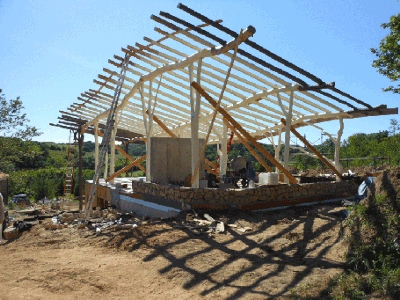What has drawn you to operating your construction company within the Driftless Region, particularly in the Soldiers Grove, WI area?
 Bryan:I was drawn to the Driftless area because of the beauty and vast supply of natural resources. As an ecological designer and natural builder, I incorporate local timber, lumber, straw, clay and stone into my projects, all of which can be sustainably harvested. I set up shop in Soldiers Grove because I prefer a small-town atmosphere with plenty of trees and wildlife right outside my door.
Bryan:I was drawn to the Driftless area because of the beauty and vast supply of natural resources. As an ecological designer and natural builder, I incorporate local timber, lumber, straw, clay and stone into my projects, all of which can be sustainably harvested. I set up shop in Soldiers Grove because I prefer a small-town atmosphere with plenty of trees and wildlife right outside my door.
Your business is based on technical skills, mastering of green and environmentally sensitive technologies, and a philosophical approach to creating shelter. I can’t think of a better mindset, but what are you seeing in the Driftless Region–what type of client are you connecting with–what are the limitations, and the opportunities for like-minded clients?
 Bryan: I meet and work with a range of clients. The two most common are retired baby boomers looking to build their forever home and younger people looking to take an active role in building a small eco-home. Both types are usually familiar with green and natural building techniques.
Bryan: I meet and work with a range of clients. The two most common are retired baby boomers looking to build their forever home and younger people looking to take an active role in building a small eco-home. Both types are usually familiar with green and natural building techniques.
Typically, the retired baby boomers can afford to do what they want, without many limitations or restrictions. My role is to design and build a sustainable and healthy home, customized to their needs.
The younger clients are a bit more challenging, because they are usually limited to a small budget. So, the goal is to design a space that meets their needs and budget. One way to overcome budget limitations is for the client to do as much work as they can, given their skill set and availability. Another is to phase-in–create the “bones”, and over time, detail it out. For the most part, it comes down to time and money. Holding workshops is another way of helping to reduce the overall cost of a project.
Is your way of building more expensive than the typical? I see the use of post and beam, sustainable materials (local, which is really interesting given our current supply chain issues), and use of actual trees within the space at times. Are there challenges in combining your construction techniques with other trades?
 Bryan: Green/Natural building is indeed more expensive than conventional construction, but a completely different “animal” is you will. The main reason for the higher cost is that the natural building systems I use are much more labor intensive and the green building technologies(solar panels, HRV’s, etc…) can add to cost where it doesn’t happen in conventional. Initially, there were challenges integrating electrical and plumbing systems into timber frame and straw bale structures, but.I’ve worked with talented and open-minded subcontractors who have helped develop systems to meet the state’s building codes and we haven’t had any major issues. It is just different.
Bryan: Green/Natural building is indeed more expensive than conventional construction, but a completely different “animal” is you will. The main reason for the higher cost is that the natural building systems I use are much more labor intensive and the green building technologies(solar panels, HRV’s, etc…) can add to cost where it doesn’t happen in conventional. Initially, there were challenges integrating electrical and plumbing systems into timber frame and straw bale structures, but.I’ve worked with talented and open-minded subcontractors who have helped develop systems to meet the state’s building codes and we haven’t had any major issues. It is just different.
As a designer, builder, and may I add, philosopher, how do you see providing shelter evolving over the coming years?
Bryan: I believe the future of my industry needs to be based on sustainable models. To me, this means using local non-toxic materials(timber, lumber, stone, clay, straw, etc…) and hiring local tradespeople to do the work. We need to move away from toxic synthetic materials, manufactured and produced thousands of miles away. Case studies have shown that modern homes made from synthetic materials release VOC’S(volatile organic compounds) that can cause serious health problems for the inhabitants.
Are you interested in training others, perhaps through an internship?
I have thought about starting an internship program, but haven’t had the type of project work to support one in the traditional sense. I’ve taught natural building workshops on timber frame, rubble trench foundations and slip form masonry in the past and really enjoyed the experience. I plan to continue to teach workshops when the appropriate project turns up. Also, I’ve been a presenter at the annual MREA fair, lecturing on ecological design and green/natural building systems.
I’m a firm believer in the idea of using education as an agent for change, so I’m always looking for opportunities to teach and pass along what I’ve learned to others.
–Bryan Dalstrom
Founder, Designer, Builder
Eco Spirit Design Studio
608-345-0916
bryan@ecospiritstudio.com

